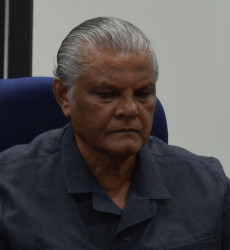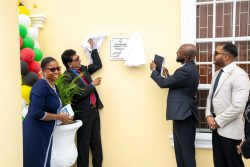The Restore Guyana project is not just a cleanup for a 50th anniversary or for Christmas but is aimed at transforming the culture and behaviour of citizens, Chairman of the National Task Force Commission Major General (rtd) Joseph Singh has stated.
Speaking at the second press briefing of the commission since its formal launch on August 12, Singh stated that the restoration project was divided into six goals and areas of concern which are all long term and will see the country make a permanent change in addressing issues such as pollution, and congestion. The six goals include: drainage; sustainable urban, rural, and hinterland physical rehabilitation; solid waste management; welfare management of the homeless, addicts, and mentally unstable; rebranding Guyana through the restoration of ethical and social responsibility; and public and stakeholders consultations.
“We will require a revolutionary transformation of us, the individuals, our homes and communities,” Singh said.

While the project is in the third month of operation, Singh said, “There was a lot of skepticism early on… Is this another project…? Is this another exercise? We tried to remove that from the minds of the people that this project is a long-term exercise.” He explained the project is divided into three phases with the first phase being the activities that have to be completed in time for next year’s 50th anniversary. Phase two, which will include rollover projects from the first phase and those which will commence at the end of phase one, will be completed by May, 2018. The last phase which comprises more strategic objectives will be completed by May, 2020. “This is a five-year project in the first instance and the idea therefore that it is a one-off exercise is not the case. This is for the long haul and it’s a project that has to be embedded in the psyche of all Guyanese. It’s the way that we intend to do business, to govern the country and self-govern within our own communities, homes, schools and so on,” he said, stating that it is not just about cleaning up and digging drains, but a total effort that will impact on everyone as individuals. “It’s very interesting to see where places have been upgraded, even in Georgetown, because it’s a clean environment people feel very guilty to drop some garbage or bottle because they are looking to see who is going to see them. It is not like before when there was so much garbage around that no one bothered. But now people are motivated, in my view, to maintain that,” he added, stating that what he noticed is happening around the city is exactly what the commission was set up to do and the message it wanted to get over.
He said that each one of the goals or concerns have national committees that have been assigned for overseeing, planning, coordinating, and implementing the projects. “For good reasons we identified public servants to head each one of those five areas because by definition they have access and its part of their responsibility anyway and they are reporting to ministers who are members of cabinet…,” he said, stating that it would be more efficient.
He explained that while the committees are functioning effectively, they have cast their nets wide and far and as such have included members from the civil society and have access to a pool of national resource persons who have expertise in the areas of concern. “Their knowledge is so extensive and broad that they bring to bear that institutional memory and advice for those persons who are in a sense young in dealing with the areas in concerned. So we have this group of people who are volunteers making themselves available,” he said, pointing out that Guyanese in the diaspora have also been assisting.
Singh said that because the commission does not actually do the physical work around the country and just has a “catalytic role” for the project, in each of the ten regions there are parallel committees that have been set up by the regions under the jurisdiction of the Regional Executive Officer (REO). “The chairman maintains oversight but basically we rely on the REOs to pull together a team of people in each region who are addressing those areas of concern,” he said, stating that the commission and the secretariat are interfacing with the ten regions and the municipalities.
Singh stated that the several communities that are slated for township in the coming year will see lots of work and infrastructural repairs done. And in the hinterland regions there will be hydropower restoration to areas where it once was. Once the plans are submitted and approved by cabinet, they will commence.
“So there’s nowhere in the country that would be unaware of the project and there is no region which has not been involved of the consultations with us on the implementation of Project Restore Guyana in the particular region,” he stated, saying that members of the task force have visited all 10 regions and had talks and also visited the ongoing projects. He said that while visiting the areas they met several persons and tried as much as possible to interface with as many persons as possible. This is being augmented by the use of a website and other social media. He said the idea is to have “… no Guyanese who wish to air their ideas about the project feel excluded from the system.”
He said that while the programme is moving smoothly there are still various “political hurdles and hoops.” He said he wants the other parties heavily involved in the activity and he hopes the invitation that was issued by the government to have someone from the opposition sit on the commission will be taken up because it is very important that people recognized that it is a national and not a political exercise. “It is here to stay and we feel that all political parties need to demonstrate their patriotism and their commitment to the good of Guyana and the well-being of the citizens and the sustainable management of the environment,” he added, stating that the commission is appealing to all “bystanders” and those “sitting on the fence” to throw in their lots with the patriotic labour of love for Guyana.
Singh said that while the commission and secretariat were not captured in the 2015 budget, they have been getting support funding from the Ministry of Public Infrastructure which allowed them to do some of the consultations and visits and to maintain an office, and a small staff. “We’ve been able to maintain that with a promise that the Ministry of Presidency will look at some interim financing… until we are catered for in the 2016 budget,” he said, stating that they have already submitted their budget which is approximately $7 million for the remainder of the year. He stressed that while the commission doesn’t do the groundwork, the funding is to ensure that the commission gets out into the fields to communicate and consult; the cost for projects is allocated in the budget.
Singh also mentioned the idea of improving the sea defences and said that while a mile of sea defence costs roughly US$1.5 million, a decision has to be made whether they will reinforce the seawall or invest in groynes.








